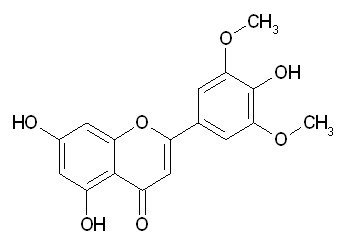| Catalogue number |
C101805 |
| Chemical name | Tricin |
| CAS Number | 520-32-1 |
| Synonyms | 5,7-dihydroxy-2-(4-hydroxy-3,5-dimethoxyphenyl)-1-benzopyran-4-one |
| Molecular Weight | C17H14O7 |
| Formula | 330.3 |
| Purity | 98% |
| Physical Description | Yellow powder |
| Solvent | Chloroform, Dichloromethane,DMSO |
| Storage | Stored at 2-8°C, Protected from air and light, refrigerate or freeze |
| Applications | Tricin is considered sufficiently safe for clinical development as a cancer chemopreventive agent, therefore it can be used for cancer prevention. It has anti-inflammatory potential and exhibits diverse biological activities including antigrowth activity in several human cancer cell lines and cancer chemopreventive effects in the gastrointestinal tract of mice.
Tricin inhibited platelet-derived growth factor (PDGF)-BB-induced cell proliferation by blocking cell cycle progression and cell migration in the human HSC line LI90 and culture-activated hepatic stellate cells (HSCs). It also reduced the phosphorylation of PDGF receptor β and the downstream signaling molecules ERK1/2 and Akt, which might be due to its tyrosine kinase inhibitor properties rather than inhibition of the direct binding between PDGF-BB and its receptor. Our findings suggest that tricin might be beneficial in HSC-targeting therapeutic or chemopreventive applications for hepatic fibrosis.
Mice received tricin (0.2%) in their American Institute of Nutrition 93G diet throughout their postweaning life span (4–18 weeks). Consumption of tricin reduced numbers of intestinal adenomas by 33% (P < 0.05) compared with mice on control diet. We explored whether tricin may exert its effect via inhibition of cyclooxygenase (COX) enzymes. Its effect on COX activity was assessed in purified enzyme preparations in vitro and its ability to reduce prostaglandin E2 (PGE2) levels in human colon–derived human colon epithelial cell (HCEC) and HCA-7 cells in vitro and in ApcMin mice in vivo. Tricin inhibited activity of purified COX-1 and COX-2 enzyme preparations with IC50 values of ∼1 μmol/L. At 5 μmol/L, it reduced PGE2 production in HCEC or HCA-7 cells by 36% (P < 0.01) and 35% (P < 0.05), respectively. COX-2 expression was reduced by tricin weakly in HCEC and unaffected in HCA-7 cells. PGE2 levels in the small intestinal mucosa and blood of ApcMin mice that had received tricin were reduced by 34% (P < 0.01) and 40% (P < 0.05), respectively, compared with control mice. The results suggest that tricin should be further evaluated as a putative colorectal cancer chemopreventive agent.
|
| References | 1. J. Agric. Food Chem., 2007, 55, 10086-10092.
2. J Cell Biochem., 2012, 113(7), 2346-2355.
3. Mol. Cancer Ther., 2005, 4, 1287.
|
| Guestbook |
|
The packaging of the product may have turned upside down during transportation, resulting in the product adhering to the neck or cap of the vial. take the vial out of its packaging and gently shake to let the compounds fall to the bottom of the vial. for liquid products, centrifuge at 200-500 RPM to gather the liquid at the bottom of the vial. try to avoid loss or contamination during handling.
| Size | Price(USD) | Discount |
| 5mg | Inquiry | N/A |
| 10mg | Inquiry | N/A |
| 25mg | Inquiry | N/A |
Orders can be placed by Emails. All orders received will be shipped in the next day if the stock is available.
To place an order, please provide the following information.
1) Your name and telephone number
2) Purchase order number
3) Product number, package size, description, and quantity
4) Shipping and billing addresses
Sent to your order to our email: info@coompo.com
If you have any questions about discounts or dealer discount, please send us a message. We will be glad to help.


